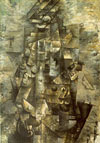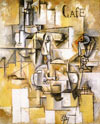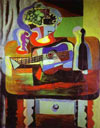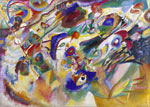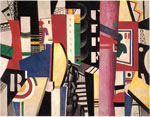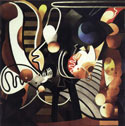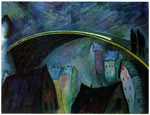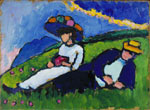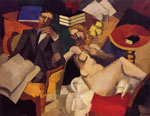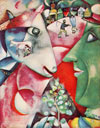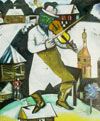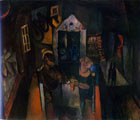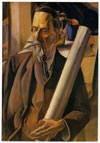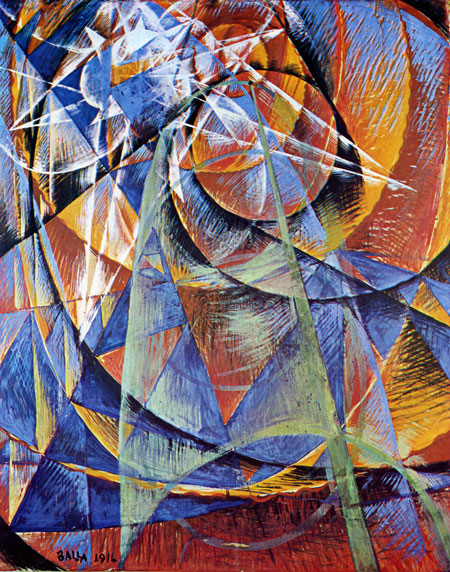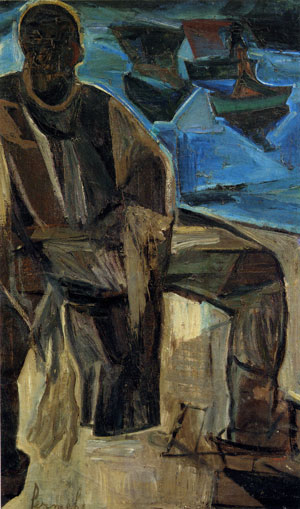
Moving Movements, History of Modern Painting, 1910 - 20
1910 - 1920: IN SPITE OF THE WORLD WAR
The impressionists didn't share Maus' democratic opinion of the freedom in style for each artist. They were hardly recognised themselves when the works of Ensor, Van Gogh and Gauguin were hanging between theirs, often strongly opposed to impressionist styles. Gauguin himself had uncompromising opinions about how modern paintings should look like: far from the impressionist works. How could anyone expect the public or the client to accept their new style, against academics and authorities?
click the thumbnails
Marcel Duchamps
Nude coming down the stairs no. 2
1912
Umbert Boccioni
Charge of the Lancers 1915
Georges Braque
Man with Guitar 1911
Pablo Picasso
The Pigeon with the little Peas 1911
Pablo Picasso
Guitar, Bottle, Fruit Dish and Glass on a Table 1919
Jean Metzinger
Natura Morta 1911
Wassily Kandinsky
Sketch 2 for Composition 7
Heinrich Campendonck
Red image with horses 1914
Arnold Schönberg
The Burrial of Mahler 1915
Franz Marc
The red Deer
Lyonel Feininger
Ships 1917
Robert Delauney
The tall Portugese 1916
Fernand Leger
City 1919
Frantisek Kupka
Cosmic Spring 1913-14
Paul Klee
Rose garden1920
Francis Picabia
Funny's Wedding 1914
Marianne von Werefkin
Schneewirbel 1915
Gabriele Münter
Jawlensky and Werefkin 1908-09
Ernst Ludwig Kirchner
The red Tower in Halle 1915
Albert Gleizes
The Swimmers 1912
August Macke
Girls under the Trees1912
Roger de la Fresnaye
Conjugal life 1913
Marc Chagall
I and the Village 1911
Marc Chagall
The Fiddler 1914
Oscar Kokoschka
The Bride and the Wind 1914
Pavel Filonov
Pancake Tuesday
(maslenitsa)
1914
Giorgio de Chirico
l' Enigma dell Arivo 1912
Giorgio de Chirico
Le Muse inquietanti 1918
Claude Monet
Reflections of clouds on the water - Lily Pond 1920
Max Ernst
You need Satan
Gustave Klimt
The Friends 1916-17
E. Reginald Frampton,
Flore des Alpes,
before 1918
Frits van den Berghe
Malpertuus1920
Zbigniew Pronaszko
Portrait of the Architect Wasilkowski 1919
Syd Long (Australia)
The Spirit of the Plains 1914
Richard Miller
La Toilette 1914
Etienne-Jules MARREY
Etienne-Jules MARREY |
Meanwhile the climate was changed. New style was trendy, accepted and praised on the condition it belonged to one of the "isms". It was based on the idea of evolution as synonym for progression. Because our society changed so quickly, mainly as a result of education and technique, the idea arose of a promising future for mankind, which was thought to be under control. Also the art had to evolve and so there should be a thread giving the right place in renovation. The society was believed to evolve towards a future in comfort and humanism, with Europe playing the leading part. Or even more: towards an ultimate world enlightenment. Obvious the art had to evolve likewise towards a supreme final state. So all renewal in art had to be seen as steps in the direction of the future golden age. This belief, mixed with national feelings, was responsible for the urge to designate a national art movement as the only possible and inescapable renovation. Also the artist wanted to propagate his work as the indispensable link in the chain of evolution, and his country as the only land were that could happen. That's why a bitter rivalry developed between the mainly French cubism and the Italian futurism. |
| In 1909 futurism arose in Italy as a literary movement, leaded by the poet and dramaturge Marinetti. In 1910 the second manifest appeared, this time signed also by painters: Boccioni,
Carra, Russolo, Balla and Severini. The dominating motive was the dynamic of modern life: speed, steal and a lot of commotion. Action and excitement took the place of contemplation. The idea to depict motion in a two-dimensional plane wasn't new. In 1878 Eadweard Muybridge made his "Horse in motion", several photos on the same paper, to make an end at the discussion if a galloping horse was or was not totally separated form the ground at a certain moment; the answer was yes. This is regarded as the first film. In 1912 Duchamps painted his "Nude coming down the stairs, number 2", clearly based on such a photos (click on the thumbnail in the colon on the right). |
Eadweard Muybridge |
Giacomo Balla, Mercurio passa davanti al sole Visto al Cannocchiale, 1914 |
The mutual critics between cubist's en futurists were no exceptions. The cubists accused the futurists having stolen some of their ideas and techniques. The futurists blamed the cubists of making a new academic art, more steadfast as what they claim to overthrow. But even in Cubism there was a great schism. One group worked towards a very calm cubism, centred around the middle or the middle axis of the canvas, looking more as abstract and very limited in colours. To make it easier, we will call this "strict cubism". Mainly practised by Picasso and Braque, whom worked so close together between 1909 and 1914, that it became sometimes difficult for them to keep their works apart. Around 1912 they began to integrate wood, sand, type letters, carbon... in their work. |
| A totally different group, sometimes called the "reasonable" or "moderate" cubists (we will call them the non-strict cubists), remained more close to the figurative. Their squares were not that explicit and also not so centred around the middle point in severe compositions. Leger, Gleizes, Metzinger, de la Fresnaye, le Fauconnier,
Lhote and Delauney met each other regularly in Puteaux. They exposed yearly in the Salon des Independents as well as the Salon d'Automne,
later on in the Salon de la Section d'Or. They were the ones which were followed abroad, for example Marc, Macke and Feininger in Germany,
or later Permeke in Belgium. The authority was moved form the academics to the critics or successful artists. Picasso was one of them. He didn't like the non-strict cubists, whom didn't want to submit to his theory. With as result that the non-strict cubists never got much attention, even not today. Maybe that's the reason Marc and Macke are often classified with the expressionists, or that Permeke, Gustaaf de Smet and Frits van den Berghe are wrongfully called "Belgian expressionists". Although they painted more and more expressive, they had very clearly their non-strict cubist period. |
Jacques Villon, Girl at the Piano, 1902 |
Germany: cubism, Die Brücke and Der blaue Reiter
In München artists learned to know each other in the Neue Kunstlervereinigung,
the NKVM, between 1909 and 1911: Kandinsky as chairman, Jawlevsky, Werefkin,
Bechtejev, Kanoldt, Baum, Hofer, Erbslöch, Münter... They held expositions together with foreigners. When Kandinsky's "Composition
V" was rejected by the NKVM, Kandinsky, Marc, Münter
and Kubin left the association. Marc and Kandinsky started a kind of annual book, edited as "Der blaue Reiter". On their first exposition
in 1911 their works were hanging together with paintings of Münter, Schönberg, Macke, Campendonck
and Delauney. For this there is spoken of a second group of German expressionism, although there has never been any group, only a loose connection. The styles were very different:
Kandinsky ever further to abstract; Campendonck,
Delauney and Marc cubist; Münter expressionist; Schönberg
symbolist and so on... Since 1912 even the works of Die Brücke were taken over on their calendar.
From
Franz Marc we often find his animal paintings made before
1913. They are already divided in areas and have unreal colours.
They are also symbolists, as a citation from him proves: "The impious man, mainly the masculine, ruling my neighbourhood, didn't touch my through feelings, while the unspoiled feeling of life of the animal made arise all what was good in me".
Franz Marc, Stables, 1913 - '14 |
In 1913 Marc became more cubist: lines are travelling through the canvas, as contours or on its own. Geometric forms came up and began to dominate. The work started looking more like stained glass windows and was still more abstract. In 1914 he became totally abstract. |
Macke painted in 1913 an uncentred cubism, with small areas, as a puzzle. The figurations remained unrecognisable, often naive, sometimes in a simple landscape. The cubist Campendonck painted colourful, much stylised figures between unrecognisable ones, with contours, or different lines, wildly mixed. In 1914 he evolved towards a more geometric abstraction. Feininger painted landscapes, strictly divided in squares or triangles, "prismatic".
Kandinsky painted in 1910 his "First abstract Aquarelle"
although he did go on working half abstract, with deformed figuration.
He had been impressed by an exposition in Den Haag about the abstract art of the Rosicrusian's in the 16th century, which weren't allowed to use figuration. (They were wept out by the Church and had nothing to do with the later Rose+Croix
of Sar Peladan.)
Kandinsky
and Delaunay propagated later their abstract art as "liberation from figuration". They did found their equal in the "abstract music" of Schönberg, but kept silence about Schönberg's figurative paintings. Kandinsky
edited essays, where he described himself as the necessary and logical continuation of Cezanne, Monet, Van Gogh, Matisse until Picasso.
Also abroad painters evolved towards abstract: Kupka, Mondriaan,
Malevitsj. Hoelzel, an artist from the colony of Dachau, painted
in 1905 already abstract.
| On the second exposition of Der blaue Reiter were also hanging works from Jawlevsky, von Werefkin and Klee, staying figurative. Klee was first working quite surrealistic, later much stylised naive, resembling Campendonck. Marianne von Werefkin worked mainly in tempera, her colours are very specific and emotional, with unreal, dramatic deformations of mountains and figures. Her work is made rich of colour by the technique of multicoloured lines put together. Wonderful are for example the apocalyptic "Liebenswirbel" (near 1917) and "Schneewirbel" (1915). |
Marianne Von Werefkin, Liebeswirbel, ca. 1917 |
Gabriële Münter's oeuvre is an example of diversity. Nevertheless there is an indescribable unity. There is also not really an evolution in her work. She was changing between fast and sketchy, spotted and not contoured (for example "Nach dem Tee", 1912, or "Abstraction", 1912) with steadily divided work in squares, strongly contoured ("Russisch Stilleben mit Teekanne", 1912). "Stilleben mit Japanfigürchen" (1910 - 13) is in fact abstract. Very revealing is the title of her work "Listening" whereon she depicted Jawlevsky, Kandinsky and Klee discussing art.
In 1913 Die Brücke ended when Heckel, Schmidt-Rodluff and Müller blamed Kirchner giving a one-sided, wrong depiction and overestimated himself in his "Chronik".
Marc Chagall, The drinking Soldier, 1911 -'12 |
Meidner,
Steinhardt and Janthur were united in a circle of artists, "Die Pathetiker". Morgner painted in 1912 - '13 his figures as shapes in several colours, in stacked strokes. Duchamps painted in a non-strict cubism, for example "Mariée" (1912). Meidner was delighted by Robert Delaunay. Permeke painted his first remarkable works, somewhere between impressionism
and expressionism. Picasso and Bracque were making sculptures with waste from dumping sites. Also Kokosjka was proving a cubist influence: dazzling squares and shadows are connected by a web of twisting lines through the whole canvas. |
Furthermore symbolism was not in the least ended. Khnopff as well as Spilliaert were on their climax. |
Pawel Filonow, Lent Vigil, 1913 - '14 |
Also impressionism did find new candidates, varying from low to splendid. Lots of this late impressionists and symbolists are still quite unknown. Meanwhile Monet painted in his large garden and made the first big wall canvas with water lilies.
The war: urinals in America, dada in Switzerland
Macke died in 1914 in the war at the age of 27, Beckman did go into war with great enthusiasm, he glorified the war. He was dismissed after collapsing. Dix, Kokosjka and Marc did fight as volunteers.
Leon de Smet fled to England. Permeke made his first masterpieces when recovering form severe injuries: "The butcher", "The cider drinker", "The stranger".
Other artists fled to America: Gleizes, Crotti, de Zayas,
Varèse, Picabia and Duchamps. Their centre figure was Stieglitz, a
pioneer in photography, with his gallery and magazine "291".
Duchamps already made a fuss on the first exhibition of new European art, the "Armory Show", in New York in 1913. The indignation towards the new imports was enormous. Duchamps had stopped painting and mocked with all arts. He began his "ready-made's"
in 1914 with a bottle-rack from the GB. With this he became extremely popular to the population of the US. In 1917 he placed the first urinal in the museum. The "work" was originally refused, but Duchamps
explained he gave it a new thought, a new point of view by giving it the title "Fountain". Duchamps made his "big glass window": there is nothing special on the glass, but the figuration is the result of complicated studies and distortions.
America had little taste and did know little more then its "realism" for a long time. The impressionism came up late, in the years '90, and in 1910 - '20 they still found new painters, as
Frieseke or Miller. When America accepted at last impressionism, it became overwhelmed by European fauvism, expressionism, symbolism,
cubism, abstract, sculptures of waste, and so on... After the shock and confusion of the "Armory Show", it was a great relief to the US they had an artist standing at their site to mock with it, so it happened art became an intellectual business. The idea became centre and was praised, the piece of art itself became unimportant.
Also in Zürich, Switzerland, art came in the ridiculous, but there it was the result of the war and was meant as an indictment.
The cabaret Voltaire began peacefully, but became more and more aggressive and absurd. The futurists were imitated, for example by reading several poems at the same time, or by tumultuous music. On stage did hang works from Picasso, Modigliani, Arp, Kandinsky, van Rees, Janco. On
the "cubist dance" and public brawl, the public answered by throwing different kinds of materials to the artists. Originally shocked, the public began to find this amusing, so dada became a bourgeois diversion.
Arp destroyed all his cubist and futurist work from before the dada period. Arp and Tauber made collages by dropping materials on the surface; coincidence as highest law.
This works were allowed to decay quickly. They collected wood and stones from forests an along the lakes. They disdained all art. Nevertheless they didn't have any contact with America.
Apollinaire died as a result of his wounds in 1918. Breton, Aragon,
Arp, Ernst and Baargeld did go to Colon in 1919 and organised an
"exposition" of dada with all kinds of absurdities, as a girl reading obscene poetry in her communion dress. A raid of the police was the result of one of the exposed works, seen as a great scandal.
When it appeared to be a work of Dürer, the manifestation was let in peace.
Schwitters made collages with all kind of waste from the streets. Ernst made collages with figures he cut from magazines and children's books. The collage had already been applied by Picasso in 1912, and even by Klimt in 1902 for his Beethoven frieze. Breton and Soupault locked themselves in a dark room to make "poetry" with free associations in "automatic writing".
In 1920 Tzara came to Paris and introduced dada. The idiotic business got great success. They gave wrong information to the press and cheated the public, which was given a free rein with tomato's and eggs.
When Breton and Tzara had an argument in 1921 dada was as good as finished,
although Tzara did go on for a while. Breton and Soupault edited their automatic writings under the title: "Les champs magnetiques".
Belgium In 1917 Permeke painted expressive and cubist, except some "landscapes" which were rather abstract. He used a lot of earth colours, but nevertheless often rich in colour. The paint is often thick, figures were clearly contoured with thick lines. Drawing and painting are mixed: his drawings look like paintings and vice versa. The lines, squares and stripes are straight, angular, powerful, the amount of squares makes the work cubist (non-centred). Also the sturdy figures and faces are like that. He was inspired by the primitive arts. Gustaaf
de Smet, Van den Berghe and Constant Permeke had a collection of African sculptures. Copyright for the text of all pages of this History of Modern Painting: Johan Framhout; text written in 1990-92; revisionned and put on the internet in 2005; translation in English 2012 |
Constant Permeke, Ostend Fisherman, 1920 |



